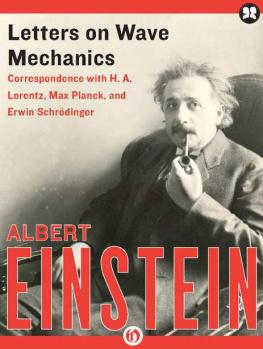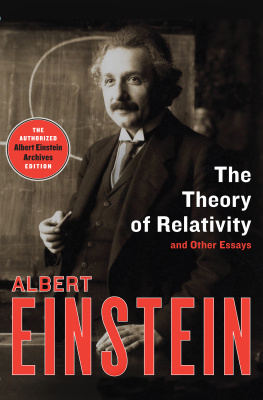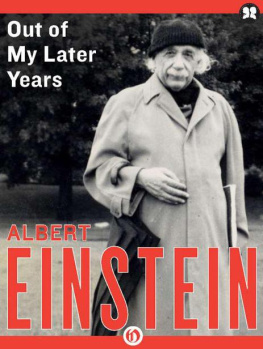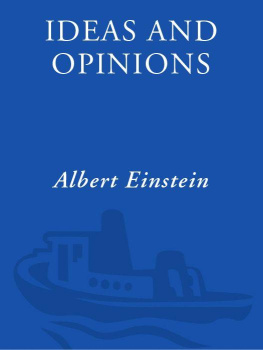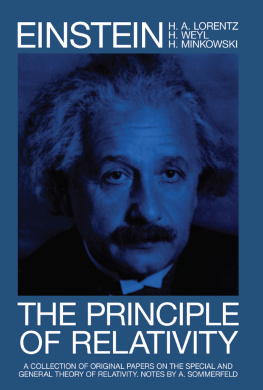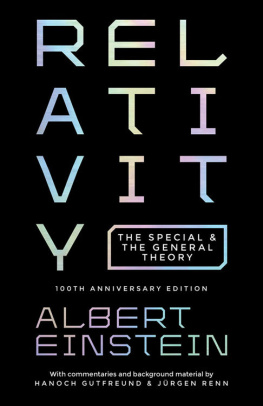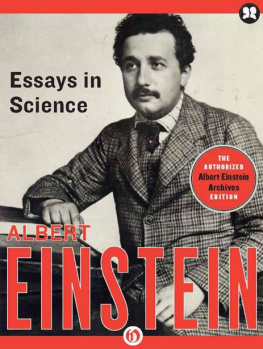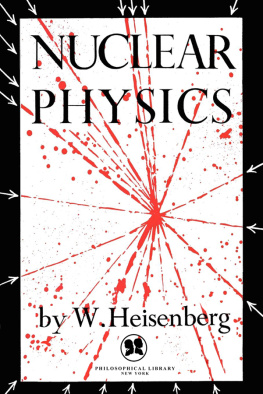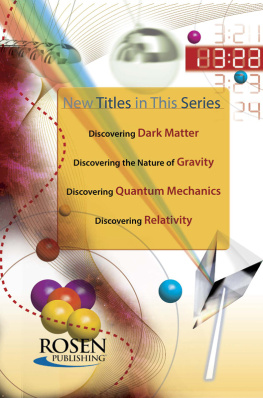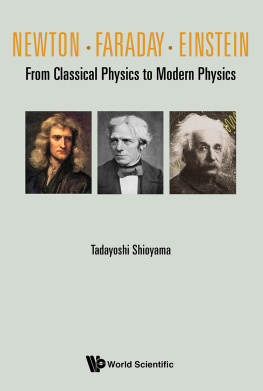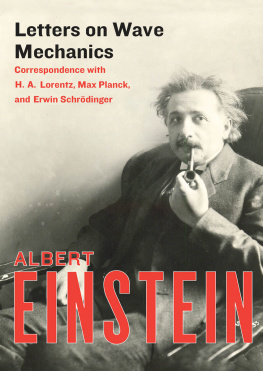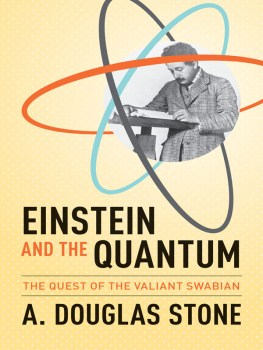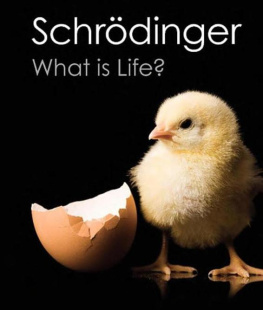Albert Einstein - Letters on Wave Mechanics: Correspondence with H. A. Lorentz, Max Planck, and Erwin Schrodinger
Here you can read online Albert Einstein - Letters on Wave Mechanics: Correspondence with H. A. Lorentz, Max Planck, and Erwin Schrodinger full text of the book (entire story) in english for free. Download pdf and epub, get meaning, cover and reviews about this ebook. year: 2011, publisher: Philosophical Library/Open Road, genre: Romance novel. Description of the work, (preface) as well as reviews are available. Best literature library LitArk.com created for fans of good reading and offers a wide selection of genres:
Romance novel
Science fiction
Adventure
Detective
Science
History
Home and family
Prose
Art
Politics
Computer
Non-fiction
Religion
Business
Children
Humor
Choose a favorite category and find really read worthwhile books. Enjoy immersion in the world of imagination, feel the emotions of the characters or learn something new for yourself, make an fascinating discovery.
- Book:Letters on Wave Mechanics: Correspondence with H. A. Lorentz, Max Planck, and Erwin Schrodinger
- Author:
- Publisher:Philosophical Library/Open Road
- Genre:
- Year:2011
- Rating:3 / 5
- Favourites:Add to favourites
- Your mark:
- 60
- 1
- 2
- 3
- 4
- 5
Letters on Wave Mechanics: Correspondence with H. A. Lorentz, Max Planck, and Erwin Schrodinger: summary, description and annotation
We offer to read an annotation, description, summary or preface (depends on what the author of the book "Letters on Wave Mechanics: Correspondence with H. A. Lorentz, Max Planck, and Erwin Schrodinger" wrote himself). If you haven't found the necessary information about the book — write in the comments, we will try to find it.
Albert Einstein: author's other books
Who wrote Letters on Wave Mechanics: Correspondence with H. A. Lorentz, Max Planck, and Erwin Schrodinger? Find out the surname, the name of the author of the book and a list of all author's works by series.
Letters on Wave Mechanics: Correspondence with H. A. Lorentz, Max Planck, and Erwin Schrodinger — read online for free the complete book (whole text) full work
Below is the text of the book, divided by pages. System saving the place of the last page read, allows you to conveniently read the book "Letters on Wave Mechanics: Correspondence with H. A. Lorentz, Max Planck, and Erwin Schrodinger" online for free, without having to search again every time where you left off. Put a bookmark, and you can go to the page where you finished reading at any time.
Font size:
Interval:
Bookmark:
Letters on Wave Mechanics
Correspondence with H.A. Lorentz, Max Planck and Erwin
Schrdinger
Albert Einstein
Edited by K. Przibram

Contents
A GREAT PHYSICAL THEORY like Schrdingers wave mechanics, when it is confirmed, takes on its own impersonal existence in the course of time, becomes completely detached from its originator, and is finally received as self-evident. In this way one forgets how many inner struggles, hopes, and disappointments were bound up with its beginnings and one forgets too all the pros and cons of contemporary reactions to it. This more personal side can be reawakened into life if there are contemporary letters like the ones reproduced here.
Schrdingers widow, Mrs. Annemarie Schrdinger, cherished the wish that her husbands correspondence concerning wave mechanics might be published among the works of the Austrian Academy of Sciences and so be made accessible to a wider scientific circle. She turned to the undersigned, as the senior among Austrian physicists, with the request that he make her wish known to the Academy. A motion concerning the publication of the letters was passed unanimously and with joyful gratitude at the meeting of the Academys Division of Mathematical and Natural Sciences on 25 January 1962; the editing was entrusted to the undersigned.
Little needs to be added to the letters; they speak for themselves. Apart from their essential content, they reveal something of the personalities of the four men of genius, corresponding to Buffons sentence, Le style cest lhomme.
There are some omissions in the carbon copies of Schrdingers letters, which were all that were available here, since the mathematical formulas that were entered by hand on the typed originals are often missing. These omissions were supplied according to the meaning and by comparison with Schrdingers published works. The other scientists communications are all in the form of hand written letters, or postcards (No. 1, 7, 10, and 12). A calculation on wave packets that filled many pages was omitted from Lorentzs second letter (No. 21); also omitted were the beginnings of letters 8, 15 and 16, which contained only personal matters, and a paragraph in letter 8 dealing with molecular statistics. The sketch in No. 12 is a facsimile in natural size. All texts are reproduced faithfully salve errore et omissione ; several inconsistencies in punctuation and style have been left uncorrected. Some (numbered) footnotes, set in smaller print, may be of assistance in giving a broader orientation.
We express our thanks to the heirs of Max Planck and H. A. Lorentz as well as to the Executor of the Estate of Albert Einstein for permission to publish the corresponding letters, and to the latter also for photographic copies of letters 13 and 15, (as well as the letter referred to in the footnote to letter 13), no carbon copies of which were to be found here.
Finally we thank the Springer-Verlag of Vienna for undertaking the publication and for its painstaking accomplishment.
K. Przibram
Vienna, Summer 1963
IN THIS ARTICLE I should like to show, first of all for the simplest case of the (non-relativistic and unperturbed) hydrogen atom, that the usual rule for quantization can be replaced by another requirement in which there is no longer any mention of integers. The integral property follows, rather, in the same natural way that, say, the number of nodes of a vibrating string must be an integer. The new interpretation can be generalized and, I believe, strikes very deeply into the true nature of the quantization rules. With these words Erwin Schrdinger began the first paper of his series, Quantization as a Proper Value Problem, sent off to the Annalen der Physik at the end of January, 1926. By the end of June he had completed four more major papers developing and applying the concepts and methods of a new wave mechanics that he hoped would be related to classical mechanics in the same way that wave optics is related to geometrical optics. What impressed him most in his elegant theory, perhaps even more than its evident power to treat a wide range of basic atomic problems, was its naturalness, its apparently intuitive character for anyone at home in classical physics, and the way in which it seemed to avoid the most perplexing and disturbing features of the existing quantum theory.
For Schrdinger was writing a quarter of a century after Max Planck had broken with the past by introducing energy quanta into physics, in order to explain the black-body radiation law. During those twenty-five years physicists had been confronted with a series of shocking departures from established modes of thought: Plancks treatment of the energy as a discrete rather than a continuous variable was followed by Einsteins modest proposals that radiation must be viewed as somehow composed of independent particles of energy and that a quantum theory of matter as well as radiation must be constructed. In 1913 Niels Bohr compounded these heresies in a theory that explicitly denied the validity of electrodynamics for atomic radiation processes and made the frequencies of atomic spectral lines independent of the frequencies of electronic motions within the atom. Bohrs ideas, strange as they seemed, served as the starting point for a serious and partly successful attempt to construct a theoretical structure that could explain the physical and chemical properties of matter, including the mysterious regularities recorded by the spectroscopists. By the spring of 1925 the theoretical picture had been elaborated by the work of many physicists into a tantalizingly incomplete and confused tangle of successes and failures, so that Wolfgang Pauli, one of the most acute, and most outspoken, of the younger theorists could write to a friend: Physics is very muddled again at the moment; it is much too hard for me anyway, and I wish I were a movie comedian or something like that and had never heard anything about physics!
Within a few months the atmosphere changed abruptly. Werner Heisenberg, in Gttingen, proposed a new approach to the riddles of the quantum theory and this new approach was quickly developed into an elaborate mathematical formalism by Max Born, Pascual Jordan and Heisenberg himself. The new theorycalled quantum mechanics by its authors but often referred to as matrix mechanics after its principal mathematical techniquegave promise of really providing the beginnings of a consistent quantum theory, for the first time. It did this, however, only at the price of an even sharper and deeper break with the past, giving up any attempt to offer a physical or intuitive picture of the processes whose outcome could be calculated, and requiring that the theory deal only with relations among quantities that could, at least in principle, be observed.
This brief and necessarily oversimplified account may give some impression of the situation in theoretical physics when Schrdingers work began to appear in the spring of 1926. I have deliberately emphasized the widespread sense of the strangeness and even the arbitrariness of the quantum theory, because it was just these properties of the theory that Schrdinger was so happy to avoid with his new wave mechanics. This happiness is evident in his papers, and especially in the paper, On the Relationship of the Heisenberg-Born-Jordan Quantum Mechanics to Mine , in which to his own surprise and joy Schrdinger was able to demonstrate the complete mathematical equivalence of these two theories, so different in their starting point, their method, and their spirit.
Most of the letters in this volume date from the spring of 1926 and give the reactions of Planck, Einstein, and Lorentz to Schrdingers ideas. Planck was obviously enraptured by Schrdingers work. Always a traditionalist, essentially conservative in his views, despite his having conceived the revolutionary idea of the quantum of energy in 1900, he welcomed just that natural or intuitive aspect of wave mechanics which so appealed to its creator.
Next pageFont size:
Interval:
Bookmark:
Similar books «Letters on Wave Mechanics: Correspondence with H. A. Lorentz, Max Planck, and Erwin Schrodinger»
Look at similar books to Letters on Wave Mechanics: Correspondence with H. A. Lorentz, Max Planck, and Erwin Schrodinger. We have selected literature similar in name and meaning in the hope of providing readers with more options to find new, interesting, not yet read works.
Discussion, reviews of the book Letters on Wave Mechanics: Correspondence with H. A. Lorentz, Max Planck, and Erwin Schrodinger and just readers' own opinions. Leave your comments, write what you think about the work, its meaning or the main characters. Specify what exactly you liked and what you didn't like, and why you think so.

